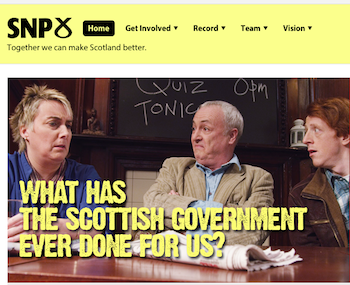Since Barack Obama successfully tapped into social media during his run to the White House in 2008, every political group has tried to use the digital world to bring in revenue and votes.
This year’s Scottish Parliament elections, which take place on May 5, will be the first in that country since Facebook and Twitter came to dominate the social web.
On an institutional level, the Scottish Parliament is the only devolved administration in the United Kingdom to not have a Twitter feed (UKParliament, AssemblyWales, niassembly are the others, along with UKYP and OfficialSYP among youth parliaments).
While Scottish businesses has caught on to the benefits of social media, local media and political parties have been more cautious and uncertain. In a country dominated by newspapers — 13 paid national daily titles daily for a population of 5.1 million — old media, and old political strategies, remain king.
Followers Don’t Equal Voters
At the political level, there were five elected parties in the Scottish chamber at the time the upcoming election was called: The Scottish National Party (who currently run the minority government), Scottish Labour, Scottish Liberal Democrats, Scottish Conservatives and the Scottish Green Party. Only the Conservatives are really right of centre, with the SNP occasionally drifting there. The major split is between nationalists (SNP and Green) and “unionists” (everyone else).
In terms of Twitter followers, as of Tuesday night the SNP is out in front with 2,815 followers, or 36.5 percent of the total of those following a major Scottish political party. Labour is a close second on 32.7 percent (2,521 followers); the LibDems have 12.9 percent (994); the Tories have 9.2 percent (710); and the Greens have 8.7 percent (668).
But followers aren’t necessarily voters. And being a digital disciple doesn’t make voting easier, especially with so many parties to choose from. Dozens of candidates will be on the proportional representation part of the ballots, as well as six or more in each first-past-the-post constituency.
The bigger problem is connecting to those who are not interested in politics. As an 18-year-old friend explained to me: “The Internet’s given us a powerful means of voicing our concerns and opinions, and social media has the added bonus of getting the word out to people you’ll likely never meet. But really, nowadays, the only people who vote are those who follow politics, or feel a duty to vote. A lot of people these days frankly don’t care because they don’t see how it affects them.”
Social media allows interaction from a distance, as well as direct contact. It is also immediate and unforgiving, so tracking politicians and parties through the medium is increasing vital.
Compare The Parties
With that in mind, I recently launched CompareTheParties.co.uk to use social media and policy comparisons to engage voters and, ideally, boost turnout, which dropped in some areas to 33 percent in 2007.
Voter apathy is a major problem across the Western world. In the same way that newspapers have frequently struggled to enthuse readers in the fragmented digital age, politicians have been caught in a cynical era that allows each individual view to trump that of an organized center.
Though it is politically diverse, Scotland is still lagging behind its American cousins in using new media, both in news and in politics. In fact, the SNP is the only party investing a notable amount of effort into social media and online engagement.
The SNP Plan
The SNP has adopted a strategy of trying to elicit contributions from citizens to their political tent through video and pictures.
Kirk Torrance, new media strategist for the SNP, started working for the party in January
2010 after helping incorporate social media into the film industry in London and Los Angeles.
“Perhaps social media has not been as successful in Scotland as in the U.S., but we are miles ahead of what other parties are doing,” he said. “We are on par with the Obama campaign and maybe a bit ahead of them now. We really have a five- to ten-year view of this stuff.”
Torrance said the party’s goal is to enthuse one voter at a time, and let those people engage with their own social networks. By reaching one, you reach many.
“You have a chain reaction possible online,” he said. “It’s a more efficient way of engaging with people. If you enthuse one person, they can enthuse others.”
The SNP strategy is to build towards a vision of Scotland, and ultimately an independent Scotland, by letting each voter define their individual version of the country. It’s a hyper-personal strategy that suits new media, but that is also plugged into a central strategic aim of getting votes.
“A lot of people think of social media as some sort of magic bullet, but it comes down to the story you’re telling,” Torrance said. “Find the emotion in what goes on and enthuse people about how great Scotland could be. The approach we’re taking is to build relationships with people on a one-to-one basis.”
The digital world has helped entrench the individual as the most important voice in society; hyper-individualism has divided much of the West, and helped unite citizens of the Middle East in town squares. The Scottish elections may, through social media activism, re-coalesce individual Scots around a town square. The square just happens to be an entire nation. And who runs it is up to the voters.
Tristan Stewart-Robertson has written for more than three dozen publications in the U.K., Canada and the U.S. in almost a decade as a reporter. Originally from New Brunswick, Canada, he completed a post-graduate degree in journalism at Cardiff University in 2002 before moving to Scotland. He worked at weekly paper the Barrhead News before moving to the Greenock Telegraph. Now working as a freelance reporter and photojournalist, operating as the W5 Press Agency, he has been published by papers including the Scotsman, Sunday Times-Herald, Toronto Star and the Chronicle-Herald.

